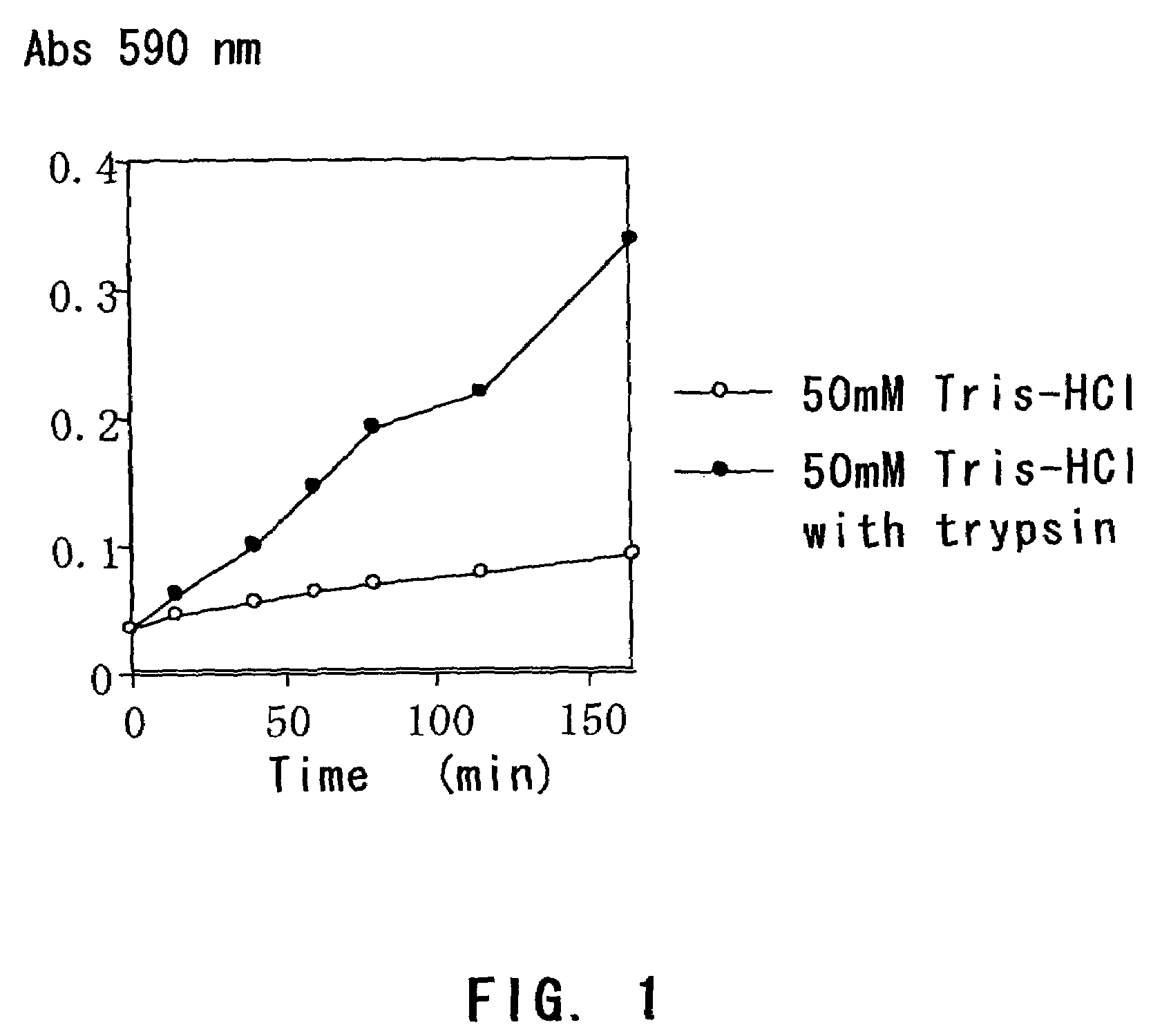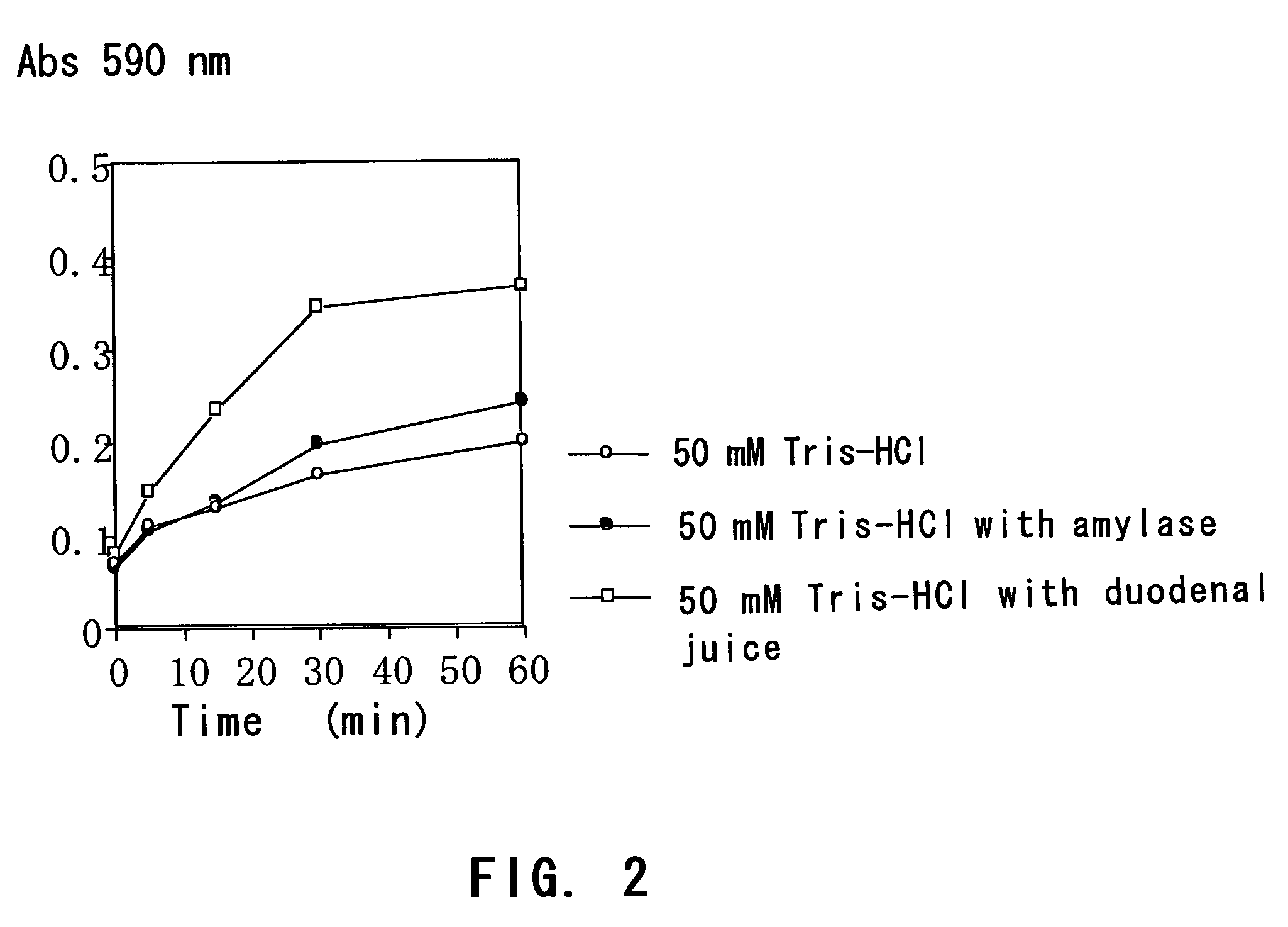Preparations for diagnosis extrapancreatic secretory function
a technology of pancreatic exocrine function and drug delivery system, which is applied in the direction of dispersed delivery, peptide/protein ingredients, and treatment, etc. it can solve the problem that the sensitivity of any of these tests is too low to detect slight decreases in pancreatic exocrine function, and cannot be repeated or used for screening, etc. problem, to achieve the effect of enhancing the release rate of compound from the carrier
- Summary
- Abstract
- Description
- Claims
- Application Information
AI Technical Summary
Benefits of technology
Problems solved by technology
Method used
Image
Examples
example 1
[0073]Solidified egg white containing trypan blue was immersed in a buffer with or without trypsin, and the time course of trypan blue elution was compared.
1-1: Method
[0074]A small amount of trypan blue was added to egg white and dissolved therein by fully stirring while preventing the formation of foam. The egg white colored in dark blue was put in a dialyzing tube (diameter: 5 mm, MWCO: 12–14,000), and boiled in a 0.4% trypan blue solution until it solidified. After 7 or 8 minutes, the dialyzing membrane was cut and removed to give two pieces of cylinder-shaped solidified egg white (5 mm in diameter×25 mm in length).
[0075]One piece of the solidified egg white was immersed in (i) 15 mL of 200 mM Pipes-K (pH 7.0), and the other was immersed in (ii) 15 mL of 200 mM Pipes-K (pH 7.0) containing 0.1% trypsin.
[0076]An aliquot (200 μl) was sampled from each of the solutions over time, and the amount of eluted trypan blue was determined by measuring the absorbance at 590 nm with a micropla...
example 2
[0078]A starch gel containing trypan blue was immersed in each of a buffer with the duodenal juice, a buffer with amylase and a buffer, and the time course of trypan blue elution was compared.
2-1: Method
[0079]A hydrolyzed starch for electrophoresis (Wako) was added to a 0.16% trypan blue solution (0.35% NaCl) to give a final concentration of 10% and then heated while stirring. When the mixed solution was viscous and clear, the solution was aspirated with a disposable measuring pipette (diameter: 4 mm) while preventing the formation of foam and solidified in cold water. After cooling for 1 hour, the gelated starch was pushed out of the measuring pipette, thereby giving three cylinder-shaped starch gels (4 mm in diameter×10 mm in length).
[0080]The gels were immersed in (i) 5 mL of 50 mM Tris-HCl (pH 8.0), (ii) 5 mL of 50 mM Tris-HCl (pH 8.0) plus 1 mL of a 344 U / L amylase solution and (iii) 5 mL of 50 mM Tris-HCl (pH 8.0) plus 1 mL of the duodenal juice (the duodenal extract solution)...
example 3
[0084]Solidified egg white containing 13C—NaHCO3 and fluorescein was administered intraduodenally to a rat with chronic pancreatitis and a control rat under anesthesia. The time course of the 13CO2 concentration in exhaled CO2 and the fluorescein concentrations in the blood and urine were compared.
3-1: Method
[0085]40 mg of 13C—NaHCO3 (Mastorace) and 3.2 mg of fluorescein were dissolved in 1 mL of distilled water, and then 7 mL of egg white was added. The resulting solution was mixed gently by pipetting while preventing the formation of foam. The mixed solution was poured into a chamber slide (Nunc, Cat# 177453), heated at 80° C. for 15 minutes to solidify the egg white containing 13C—NaHCO3 and fluorescein. After being left to cool, the solidified egg white was cut out with a disposable measuring pipette (4 mm in diameter), thereby forming a cylinder of solidified egg white (200 μL in volume).
[0086]The chronic pancreatitis rat was prepared by injecting oleic acid into the pancreatic...
PUM
| Property | Measurement | Unit |
|---|---|---|
| Polymeric | aaaaa | aaaaa |
Abstract
Description
Claims
Application Information
 Login to View More
Login to View More - R&D
- Intellectual Property
- Life Sciences
- Materials
- Tech Scout
- Unparalleled Data Quality
- Higher Quality Content
- 60% Fewer Hallucinations
Browse by: Latest US Patents, China's latest patents, Technical Efficacy Thesaurus, Application Domain, Technology Topic, Popular Technical Reports.
© 2025 PatSnap. All rights reserved.Legal|Privacy policy|Modern Slavery Act Transparency Statement|Sitemap|About US| Contact US: help@patsnap.com



